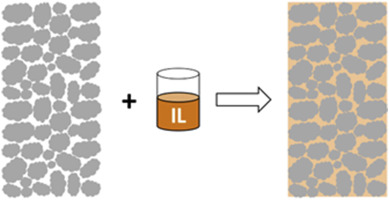Journal of Power Sources ( IF 9.2 ) Pub Date : 2017-12-21 , DOI: 10.1016/j.jpowsour.2017.12.037 Carmen de la Torre-Gamarra , Giovanni Battista Appetecchi , Ulderico Ulissi , Alberto Varzi , Alejandro Varez , Stefano Passerini

|
Ceramic electrolytes are prepared through sintering processes which are carried out at high temperatures and require prolonged operating times, resulting unwelcome in industrial applications. We report a physicochemical characterization on hybrid, sodium conducting, electrolyte systems obtained by coating NASICON ceramic powders with the N-butyl-N-methylpyrrolidinium bis(trifluoromethanesulfonyl)imide ionic liquid. The goal is to realize a ceramic-IL interface with improved sodium mobility, aiming to obtain a solid electrolyte with high ion transport properties but avoiding sintering thermal treatment. The purpose of the present work, however, is showing how simply combining NASICON powder and Py14TFSI does not lead to any synergic effect on the resulting hybrid electrolyte, evidencing that an average functionalization of the ceramic powder surface and/or ionic liquid is needed. Also, the processing conditions for preparing the hybrid samples are found to affect their ion transport properties.
中文翻译:

Na 3 Si 2 Y 0.16 Zr 1.84 PO 12离子液体混合电解质:实现固态钠离子电池的一种方法?
陶瓷电解质是通过烧结工艺制备的,该烧结工艺在高温下进行并且需要延长的操作时间,因此在工业应用中不受欢迎。我们报告了通过用N-丁基-N-甲基吡咯烷鎓双(三氟甲磺酰基)酰亚胺离子液体涂覆NASICON陶瓷粉末而获得的混合钠导电电解质体系的理化特性。目的是实现具有改善的钠迁移率的陶瓷-IL界面,旨在获得具有高离子传输性能但避免烧结热处理的固体电解质。但是,本工作的目的是说明如何简单地将NASICON粉和Py 14结合在一起TFSI不会对所得混合电解质产生任何协同作用,证明需要陶瓷粉末表面和/或离子液体的平均功能化。而且,发现制备混合样品的加工条件会影响其离子传输性能。


























 京公网安备 11010802027423号
京公网安备 11010802027423号